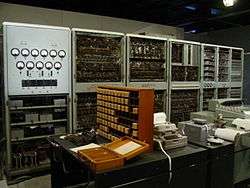Jean-Claude Risset
Jean-Claude Risset (French: [ʁisɛ]; 18 March 1938 – 21 November 2016) was a French composer, best known for his pioneering contributions to computer music. He was a former student of André Jolivet and former co-worker of Max Mathews at Bell Labs.
Risset was born in Le Puy-en-Velay, France. Arriving at Bell Labs, New Jersey in 1964, he used Max Mathews' MUSIC IV software to digitally recreate the sounds of brass instruments. He made digital recordings of trumpets and studied their timbral composition using "pitch-synchronous" spectrum analysis tools, revealing that the amplitude and frequency of the harmonics (more correctly, partials) of these instruments would differ depending on frequency, duration and amplitude. He is also credited with performing the first experiments on a range of synthesis techniques including FM Synthesis and waveshaping.
After the discrete Shepard scale Risset created a version of the scale where the steps between each tone are continuous, and it is appropriately called the continuous Risset scale or Shepard-Risset glissando.
 |
A Shepard-Risset glissando
|
| Problems playing this file? See media help. | |
He has also created a similar effect with rhythm in which tempo seems to increase or decrease endlessly.[1][2] He died in Marseille on 21 November 2016.
 |
Risset's rhythmic effect - a breakbeat that accelerates forever
|
| Problems playing this file? See media help. | |
Selected works by Jean-Claude Risset
Vocal music
- Dérives, for choir and magnetic tape (1985) 15'
- Inharmonique, for soprano and tape (1977) 15'
Orchestral music
- Escalas, for large orchestra (2001) 17'
- Mirages, for 16 musicians and tape (1978) 24'
Chamber music
- Profils, for 7 instruments and tape (1983) 18'
- Mutations II for ensemble and electronics (1973) 17'
Solo music
- Trois études en duo, for pianist (bidirectional MIDI piano with computer interaction) (1991) 10'
- Huit esquisses en duo, for pianist (bidirectional MIDI piano with computer interaction) (1989) 17'
- Voilements, for saxophone and tape (1987) 14'
- Passages for flute and tape (1982) 14'
- Variants for violin and digital processing (1995) 8'
Music for solo tape
- Invisible Irène (1995) 12'
- Sud (1985) 24'
- Songes (1979) 10'
- Trois mouvements newtoniens, for tape (1978) 13'
- Mutations (1969) 10'
- Computer Suite from Little Boy (1968) 13'
References
- ↑ Risset, Jean-Claude (1986), "Pitch and rhythm paradoxes: comments on "Auditory paradox based on fractal waveform"", Journal of the Acoustical Society of America, 80 (3), pp. 961–962, PMID 3760341, doi:10.1121/1.393919
- ↑ Stowell, D (2010), "And the beat goes on...forever?", cs4fn Audio! Magazine (3)
Sources
- Baudouin, Olivier, Pionniers de la musique numérique, Sampzon, Delatour, 2012.
- Portrait polychrome n°2 : Jean-Claude Risset, INA/CDMC Publisher, 2001 (ISBN 2-86938-177-8)
External links
- Mode Records profile: Jean-Claude Risset
- The Living Composers Project: Jean-Claude Risset
- "biography" (in French). IRCAM.

%2C_June_13%2C_2011.jpg)